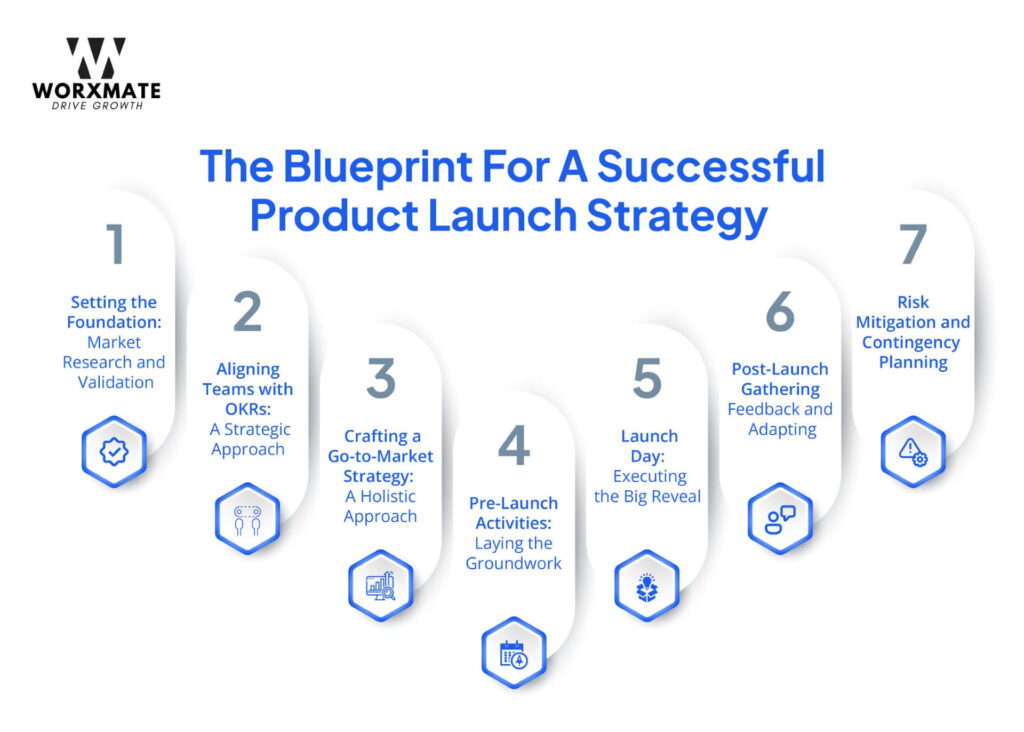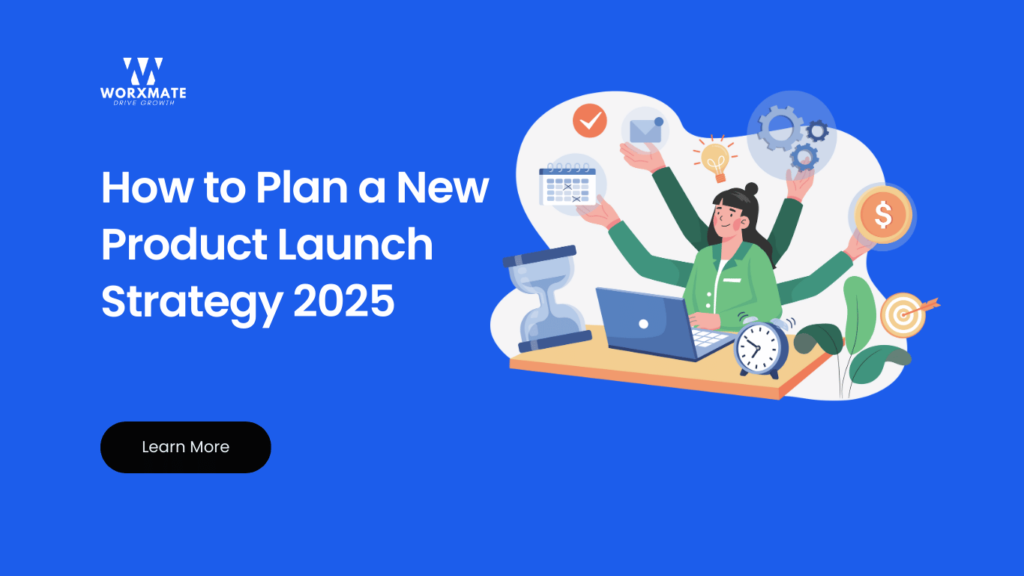Summary :
To plan a successful product launch strategy in 2025, start with thorough market research and customer validation to ensure product-market fit. Align internal teams using OKRs to maintain focus and accountability. Build early buzz through pre-launch campaigns, influencer partnerships, and beta testing. On launch day, coordinate messaging across all channels, and post-launch, collect feedback to iterate and improve the product. A data-driven, customer-centric approach increases launch success and long-term growth.
Out of nearly 30,000 products launched every year, 95% miss the mark. It’s not because the product lacks innovation but because many businesses overlook the most critical element: the strategy.
A great product is only as successful as its launch strategy, which ensures it resonates with the right audience, at the right time, and through the right channels.
Take Google Glass as an example. Despite the anticipation surrounding its innovation, the product flopped due to poor market validation and a misunderstanding of customer needs. This case highlights that even the biggest names can falter when the right strategies aren’t in place.
In a world where first impressions are everything, how can you ensure your product stands out, hits the right audience, and delivers on expectations? The answer lies in a carefully crafted, data-driven launch strategy which we’re about to unfold.
The Blueprint for a Successful Product Launch Strategy

1. Setting the Foundation: Market Research and Validation
At the core of any successful product launch lies market research. Without it, you’re essentially launching in the dark, hoping that your product finds traction.
According to Hanover Research, 86% of businesses that conduct market research report an ROI of more than 4x.
Conducting thorough research—identifying customer pain points, competitive landscape, and market trends—helps refine the product’s positioning
How to get it right:
-
Customer Personas:
Define who your product is for by creating detailed customer personas. Answer questions like- Who is your ideal customer? What are their pain points, desires, and behaviors? The more granular your understanding of your target audience, the better you can tailor the product and its messaging.
-
Market Segmentation:
Narrow down potential markets to target the most promising segments based on demographic, psychographic, and behavioral data. By segmenting your target audience and studying their preferences, you gain valuable insights that guide everything from product features to marketing messages. Utilizing tools like focus groups, customer surveys, and competitive analysis will help you ensure that your product solves a real problem.
-
Validating Your Concept:
Before investing heavily in development, validate your product idea through:
-
Prototyping:
Test early versions with potential customers.
-
Beta Testing:
Allow select users to experience the product and gather feedback.
Companies that skip this validation phase often end up spending more time and money fixing post-launch issues, or worse, launching a product that no one wants. A prime example is Microsoft’s Zune, which failed to capture the market dominated by the iPod, primarily due to poor market research and a lack of unique positioning.
2. Aligning Teams with OKRs: A Strategic Approach
While market research provides a solid foundation, alignment across your organization is crucial for successful execution. This is where Objectives and Key Results (OKRs) come into play.
While your launch strategy doesn’t revolve entirely around OKRs, integrating them can offer alignment across teams, especially when balancing innovation with execution.
What OKRs bring to the table:
- Alignment: Ensure your marketing, sales, and product development teams are all driving towards the same objective—whether it’s capturing market share, achieving sales milestones, or building brand awareness.
- Measurability: Use key results to define what success looks like. For example, an objective might be to ‘Increase brand visibility’ with key results like ‘Achieve 1000+ pre-orders within the first month of launch.’
OKRs not only set measurable targets but also provide a framework for teams to coordinate and track progress. This ensures that everyone is working towards the same high-level goals, mitigating risks like scope creep or misaligned priorities.
Accelerate Your Product Launch with the Right OKRs!
3. Crafting a Go-to-Market Strategy: A Holistic Approach
Your Go-to-Market (GTM) strategy is the bridge between concept and customer. This strategy encompasses everything from branding and pricing to distribution channels and launch timing.
-
Choosing the Right Channels
The best-laid product launch strategy can fail without the right distribution. You need to carefully select the channels that will effectively reach your target audience. These could be e-commerce platforms, physical retail outlets, or direct-to-consumer (DTC) websites.
For instance, Apple’s iPhone launch succeeded not just because of its innovation, but because of its well-orchestrated distribution plan—from its own stores to carriers worldwide, every channel was leveraged to maximize visibility and accessibility.
-
Pricing and Positioning
Pricing is one of the most critical elements of a product launch. If priced too high, you risk alienating potential customers; if priced too low, you risk undercutting your profit margins and brand perception.
You can employ a penetration pricing strategy to attract early adopters and build market share or opt for premium pricing to position the product as exclusive. The key is to align pricing with both your business goals and the expectations of your target audience.
Secondly, it’s also significant to define how your product fits into the market and what makes it stand out from competitors. Remember to keep the message simple and resonate with your audience’s needs.
4. Pre-Launch Activities: Laying the Groundwork
A successful product launch doesn’t happen overnight. The pre-launch phase is where much of the heavy lifting happens. Think of it as priming your market so that when launch day arrives, there’s already a buzz, a demand, and eager customers waiting to try your product.
-
Building Anticipation and Buzz
Generating excitement before the product is available is a powerful way to ensure a successful launch. Tesla has perfected this with its model releases, using limited sneak peeks, pre-order campaigns, and influencer partnerships to build demand well in advance.
Here are a few things to consider:
-
Early Access & Beta Testing
Involve a select group of users in early access or beta testing programs to create advocacy for your product. According to Harvard Business Review, products that undergo beta testing have a 30% higher likelihood of successful launches.
-
Pre-launch Content Marketing
Use blogs, webinars, and social media campaigns to educate your target audience on the problem your product solves and why it’s the best solution. SEO-driven content like whitepapers, explainer videos, and product demos can significantly boost visibility.
-
Partnerships and Influencers
Strategic partnerships can elevate your product to new heights. Partnering with influencers, bloggers, or industry experts to review your product ahead of time creates early credibility. According to Think With Google, 70% of teens trust influencers more than celebrities.
For example, GoPro’s successful partnerships with influencers in the adventure sports space allowed them to build a loyal customer base even before their cameras hit the mainstream market
5. Launch Day: Executing the Big Reveal
After months of preparation, it all culminates on launch day. This is where your strategy shifts from planning to execution.
-
Coordinating Across Channels
On launch day, your messaging needs to be consistent across all channels. Whether you’re running paid ads on social media, sending email campaigns, or using influencer partnerships, it’s essential that your product’s core message remains clear and unified.
-
- Real-time Customer Engagement: Use live streams, virtual events, or product demonstrations to engage your audience directly. Real-time interaction can generate excitement, allowing customers to ask questions and witness the product in action.
- Press Releases & Media Coverage: Ensure that industry publications and media outlets have early access to your product, so they can help you amplify your reach through their platforms.
6. Post-Launch: Gathering Feedback and Adapting
The work doesn’t end when your product hits the market. In fact, the post-launch phase is just as important as everything that came before it. Your ability to listen to customer feedback and adapt quickly can make or break long-term success.
-
Customer Feedback Loops
The post-launch phase is an opportunity to refine your product and address any unforeseen issues. Setting up multiple feedback channels—such as customer surveys, social media monitoring, and in-app feedback tools—allows you to gather real-time insights into how your product is being received.
-
- Monitor sales figures and engagement rates. Use tools like NPS (Net Promoter Score) to gauge customer satisfaction and identify brand advocates who can help promote your product further.
-
Iterating and Improving
Customer feedback will reveal what’s working and what needs improvement. Having a continuous improvement loop means that your product is always evolving based on real-world usage. This agile approach allows you to fix bugs, improve features, and enhance customer satisfaction.
Dropbox is an excellent example of a company that iterated based on user feedback post-launch. Their initial version of the cloud storage tool was much simpler than what we see today, but by listening to users, they continually added features that solved real-world problems.
7. Risk Mitigation and Contingency Planning
Even with a perfectly crafted strategy, unforeseen circumstances can still disrupt a product launch. Preparing for potential risks is key to minimizing impact and pivoting when necessary.
-
Risk Mitigation Through Scenario Planning
Before your product hits the market, engage in scenario planning to anticipate possible pitfalls. What if your supply chain breaks down? What if early reviews are negative? Having contingency plans in place for these scenarios can prevent a total derailment.
For example, when Samsung’s Galaxy Note 7 encountered battery issues post-launch, the company swiftly issued recalls and re-launched the product with modifications, preventing further damage to its reputation.
-
Leveraging OKRs for Risk Management
OKRs can also be valuable in risk mitigation. By setting Key Results focused on identifying and addressing potential risks early in the process, you’ll ensure that your team has the agility to respond to problems swiftly and efficiently.
Final Thoughts
Crafting a winning product launch strategy is both an art and a science. It requires deep market research, internal alignment, a meticulous go-to-market plan, and the agility to adapt based on customer feedback. By incorporating a strategic framework like OKRs, businesses can set clear goals and measure success at every stage of the launch process.
Whether it’s through carefully curated partnerships, thoughtful pre-launch activities, or continuous post-launch iterations, your product’s journey from concept to market must be intentional, customer-driven, and adaptable. Success doesn’t end on launch day—it’s a continuous process of refining, improving, and expanding your product’s value over time.
Now, it’s time to take the next step!
Explore the best OKR software to empower your team with the tools needed for seamless planning and execution. With the right OKR software, you can easily track progress, adapt in real-time, and drive alignment at every stage of your journey. Start exploring today and unlock your organization’s full potential! Ready to see it in action? Book a Demo and experience how it can transform your goal-setting process



